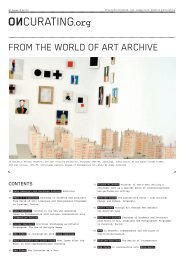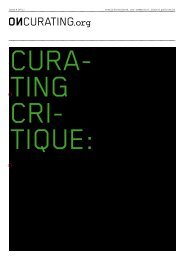Create successful ePaper yourself
Turn your PDF publications into a flip-book with our unique Google optimized e-Paper software.
070 Issue # 11/11 : PublIc Issues<br />
unless s/he is invited to diplay works at an exhibition.<br />
We realized it is important for us to be in that particular<br />
space in Galata. It w<strong>as</strong> important for us to be able<br />
to realize a project we had in mind right there whenever<br />
we wanted. Oda Project transformed later on, of course.<br />
At this point, it is also important to take the initiative.<br />
The second resistance, I believe, involves producing<br />
art beyond all kinds of top-down definitions<br />
or requests. We can resist the macro by researching micro-<br />
situations and relationships, and by looking at their<br />
dynamics.<br />
Seçil: I rather think that Oda Projesi purposefully enacts<br />
resistance. It's rather a matter of reading a particular<br />
project in such a way retrospectively. We create gestures<br />
of resistance. But I cannot claim something like we re-<br />
sisted this first, and later we resisted that. Resistance<br />
is a process. It contains tensions and conflicts; in some<br />
are<strong>as</strong> you win, in others you lose. During resistance,<br />
the sides feel the presence of their rivals, and resistance<br />
emerges accordingly. Resistance is something more than<br />
opposition; it creates new spaces. And there is a continuity<br />
in resisting.<br />
Günes¸: For me the project involved curiosity rather than<br />
resistance at the beginning. This involved creating a<br />
space for ourselves in a declining neighborhood in central<br />
Istanbul and transforming it over time into a space of<br />
resistance. I also think that we interpreted this <strong>as</strong> resis-<br />
tance retrospectively. Well, opening an art space and<br />
funding this with pocket money in the midst of a huge art<br />
system is itself a kind of resistance. However, I think we<br />
weren't necessarily doing all this <strong>as</strong> a challenge to that<br />
system; or at le<strong>as</strong>t I didn't think of it that way <strong>as</strong> a<br />
member of the collective at the time.<br />
Aesthetics-Ethics<br />
Derya: Let me raise another question, again by referring<br />
to Bishop's argumentation: how does Oda Projesi see<br />
the relationship between aesthetics and ethics? How does<br />
it approach aesthetics? Does it sacrifice aesthetics in<br />
favour of ethics, <strong>as</strong> Bishop puts it? What are the roles<br />
of aesthetics and ethics in the works of Oda Projesi, and<br />
how and where do they arise?<br />
Özge: Well, Bourriaud's Relational Aesthetics w<strong>as</strong> also<br />
criticised. Perhaps here we should talk a little bit<br />
about the risks of aestheticisation. For instance, while<br />
Istanbul is not an aesthetic city in the most well-known<br />
meaning of the term <strong>as</strong> that which is beautiful, it is being<br />
aestheticised. The fact that there is always an act of<br />
aestheticisation behind the notion of aesthetics somewhat<br />
annoys me. I think Oda Projesi creates a series of scenes<br />
– aesthetic or not. A possible scene of what could be done<br />
together, micro set-ups, etc. When I say scene, I don't<br />
only mean this in a visual sense of the word, of course.<br />
I am talking about an approach that realizes projects with-<br />
out thinking via aesthetics.<br />
Ethics work similarly. We realize a project without thinking<br />
ahead about its artistic success or failure. We simply<br />
rely on our personal ethics, <strong>as</strong> we move along proportionally<br />
with everyday life. If you establish a rule for this is<br />
ethical and that is not, you unavoidably end up otherising<br />
whom you are faced with. But if you see your counterpart<br />
<strong>as</strong> someone with whom you can share an experience, at that<br />
point the relationship between you and the other develops<br />
its own specific ethics. It is also useful to think the<br />
other way around: we have also produced products and we<br />
cannot ignore their relation-<br />
ship with aesthetics. None-<br />
theless, the aesthetic is<br />
not necessarily bad. But I<br />
say we cannot talk about an<br />
aesthetic structure in the<br />
works of Oda Projesi, because<br />
this isn't our aim. In other<br />
words, I think aesthetics<br />
is something that you aim at,<br />
where<strong>as</strong> we have no such aims<br />
in our way of production:<br />
we produce by taking risks;<br />
and we usually don't make<br />
decisions in advance about<br />
how a project will end.<br />
Community<br />
Derya: I would like to come<br />
back to one of my initial<br />
questions: how does Oda Pro-<br />
jesi approach the neighbourhood<br />
community? Do you aim<br />
to achieve community em-<br />
powerment? This also raises<br />
another question, namely,<br />
about the place of subjecti-<br />
vity in Oda Projesi's works.<br />
How relevant is the distinction<br />
between the self and<br />
the other (which Bishop also<br />
talks about) in the neighbourhood?<br />
Özge: In fact, the problem<br />
is right there. Christian<br />
Kravagna (1998) also talks<br />
about an approach that he<br />
calls "working with others".<br />
I think this is a problematic<br />
approach. For Oda Pro-<br />
jesi, the question of "who<br />
are our neighbors?" w<strong>as</strong><br />
always important. Community,<br />
in this sense, corresponds<br />
to those sharing a common<br />
space. If we think of a com-<br />
mon space, then Oda Projesi<br />
is one of many community<br />
members who share this space;<br />
that is, it is integral<br />
to that community. In this<br />
sense, we cannot talk about<br />
a target group; never-<br />
theless, many times we are<br />
labeled <strong>as</strong> "Oda projesi works<br />
with such and such kinds of<br />
groups". At this point, I<br />
think we should rethink Oda<br />
Projesi's definition of com-<br />
munity via space. Those who<br />
share a common space make<br />
a community; life takes shape<br />
in relation to space and<br />
space in turn takes shape<br />
in relation to life. Sharing<br />
<strong>as</strong> neighbors is important,<br />
because only then can we talk<br />
about exchange. Experiences


![Download as PDF [10.6 MB]](https://img.yumpu.com/4266533/70/500x640/download-as-pdf-106-mb.jpg)

